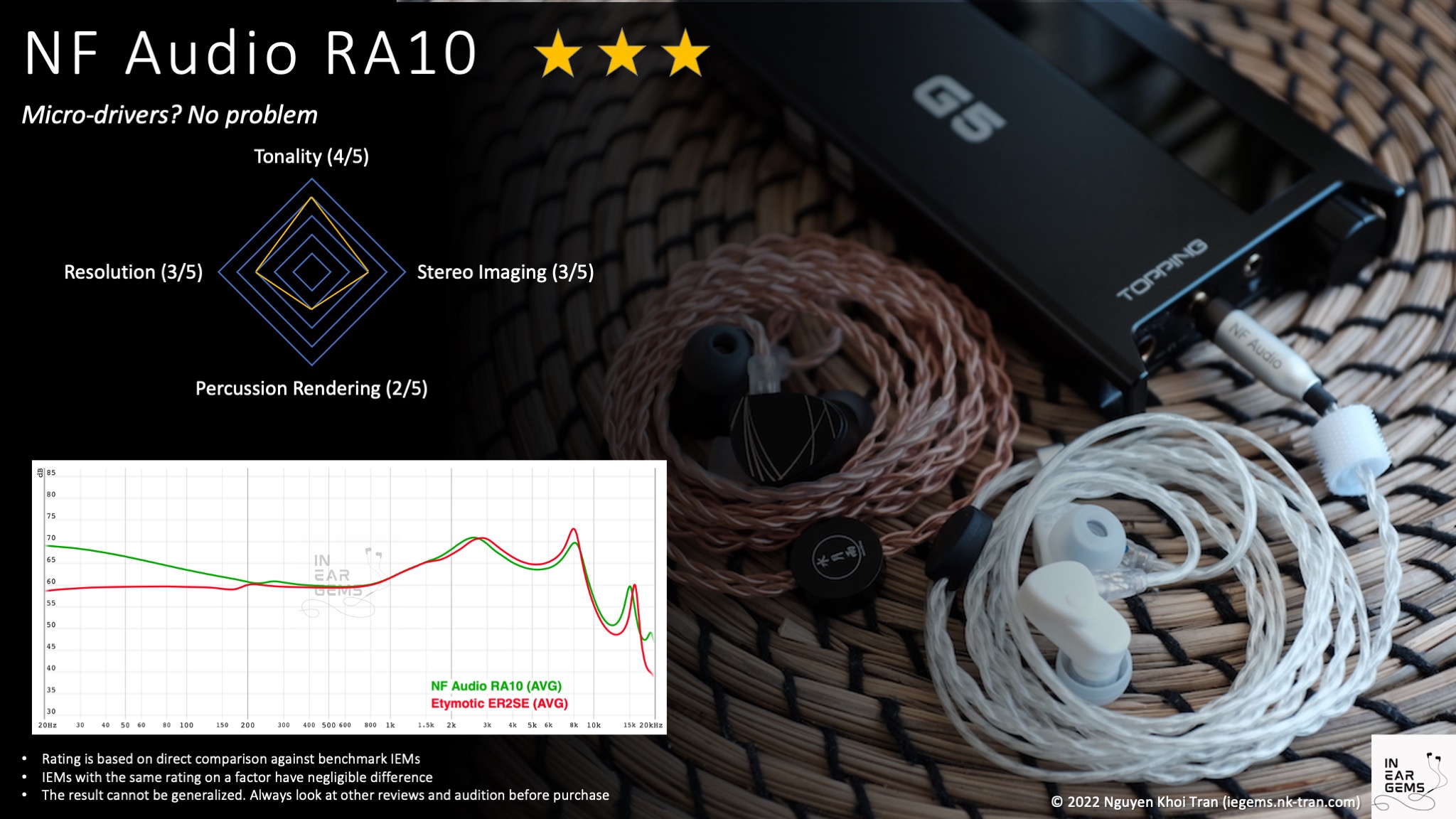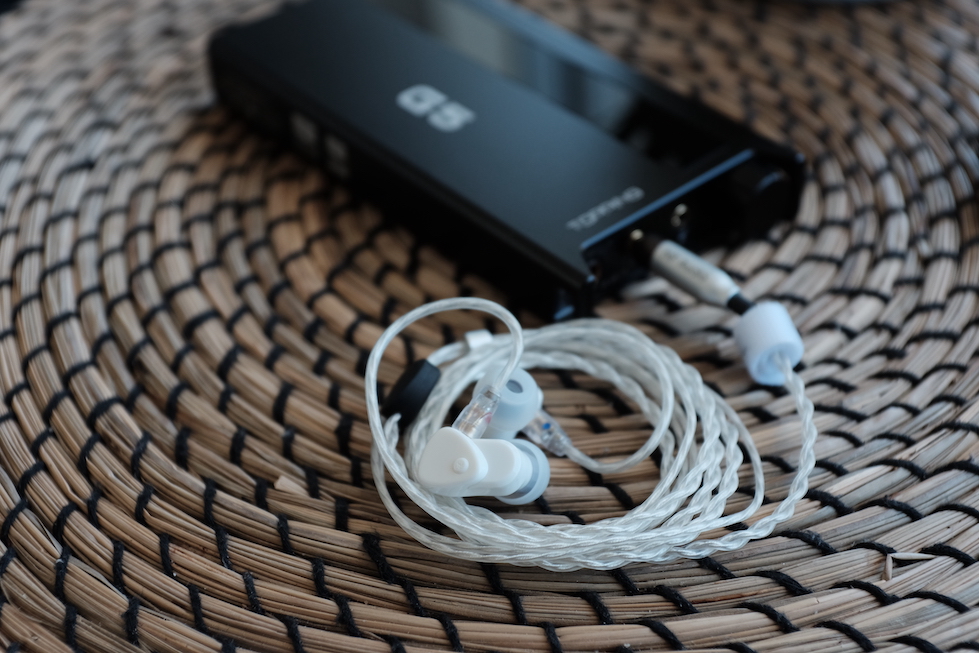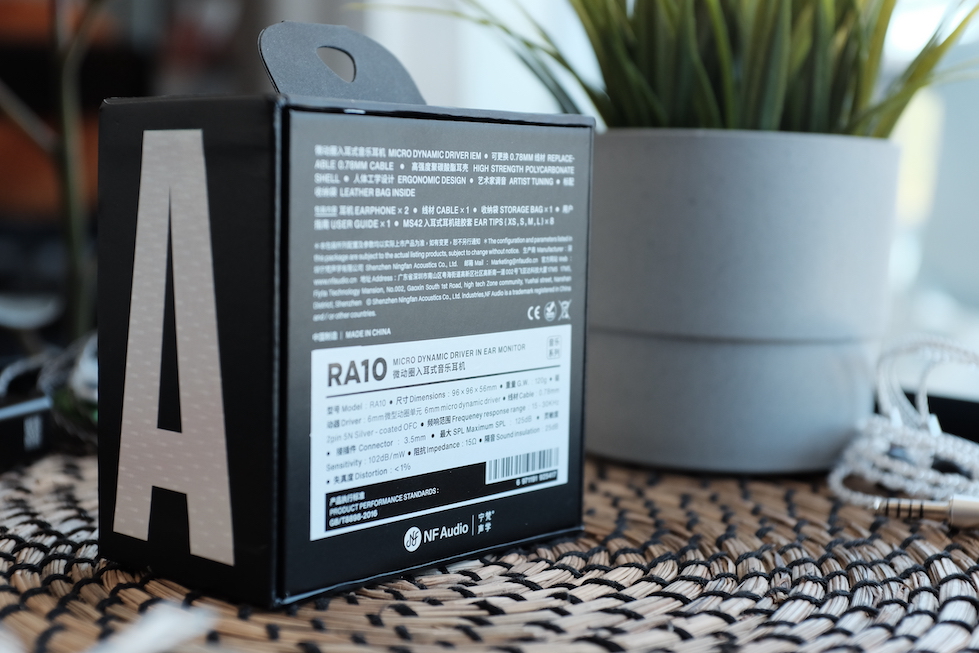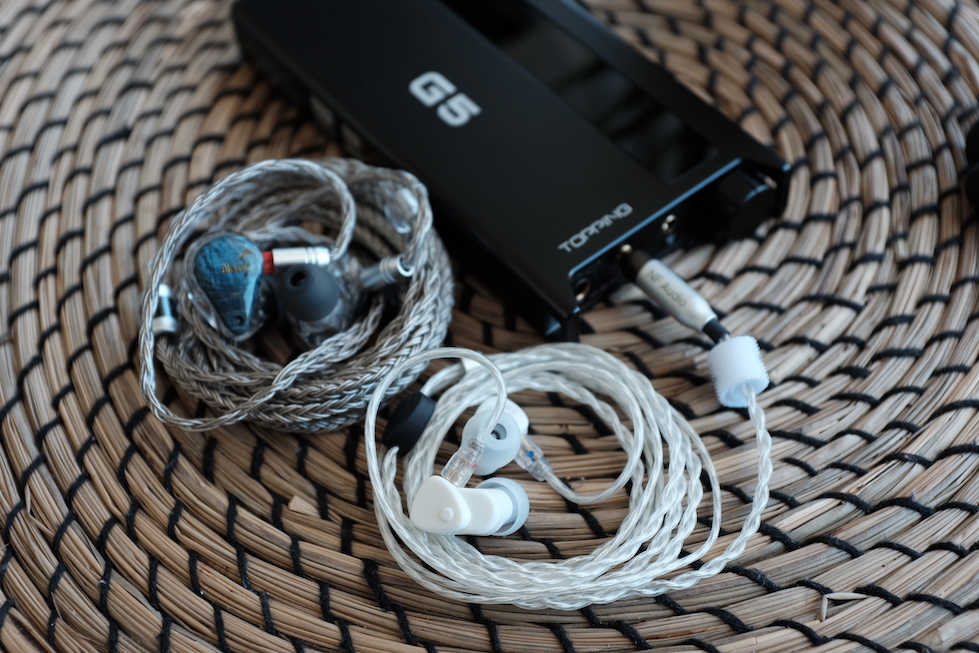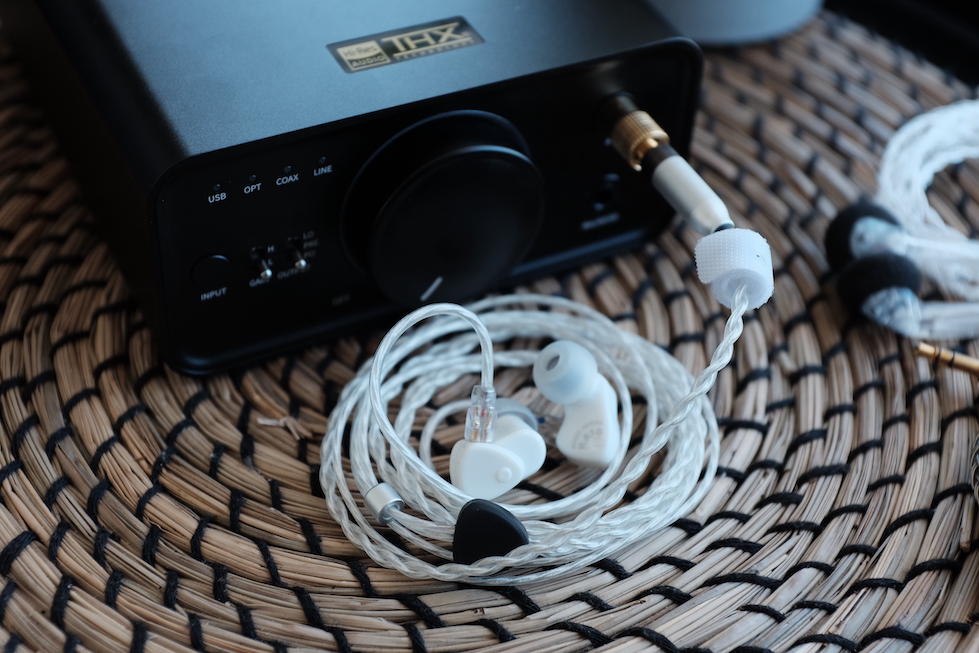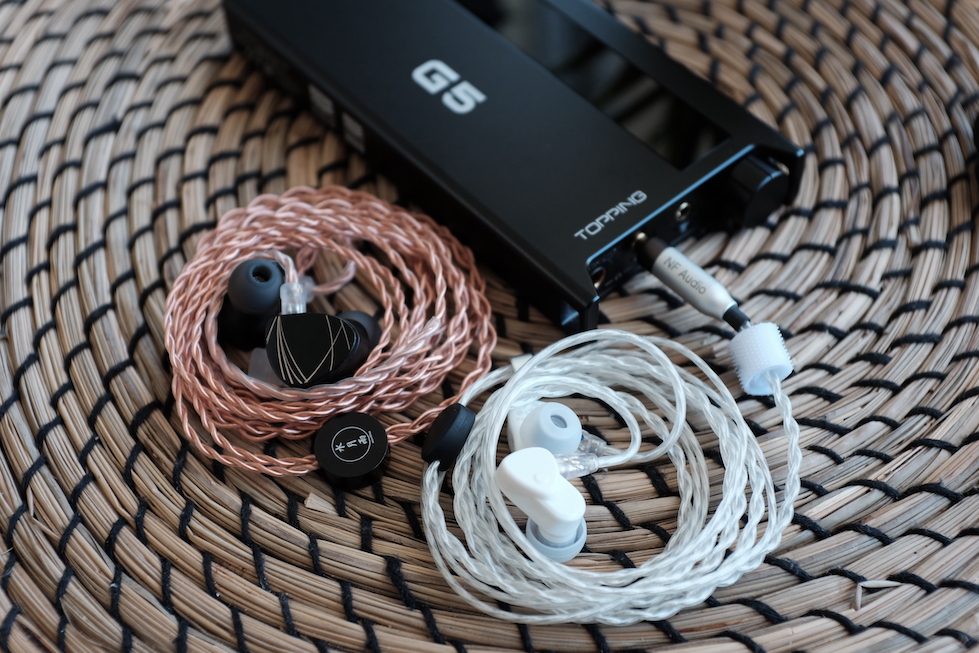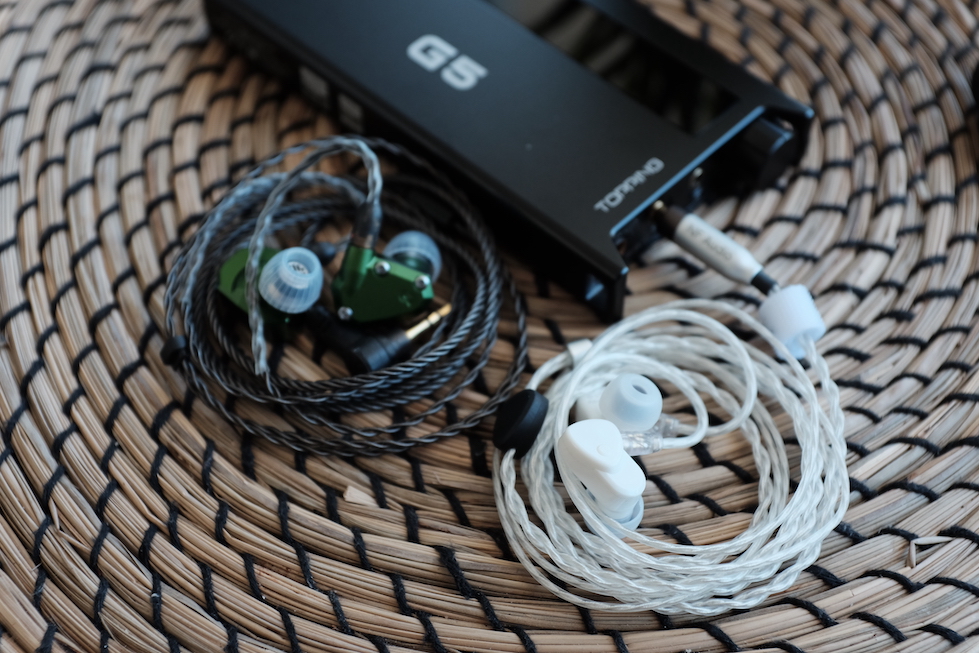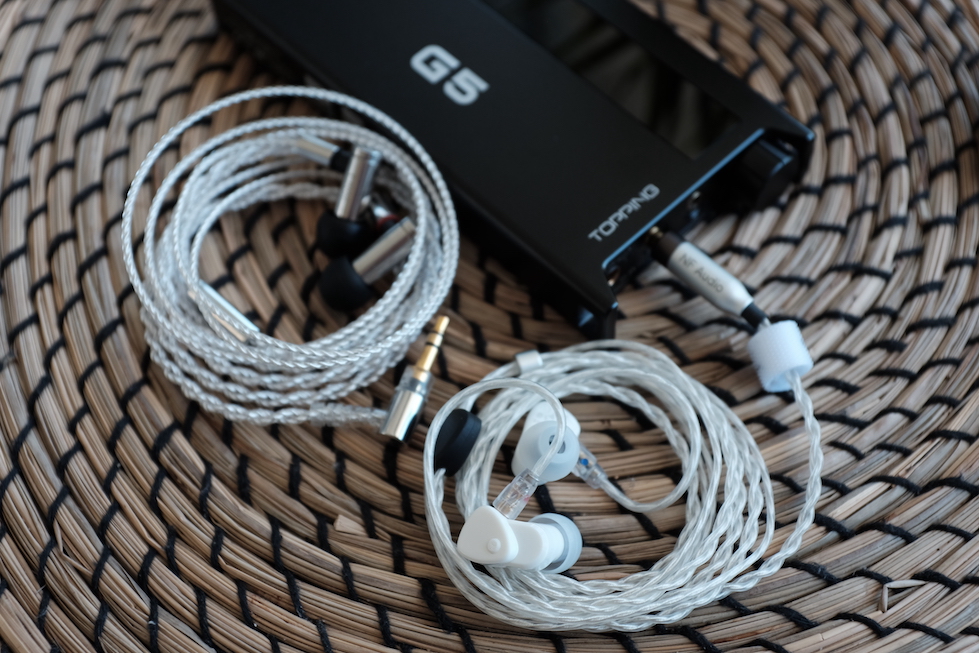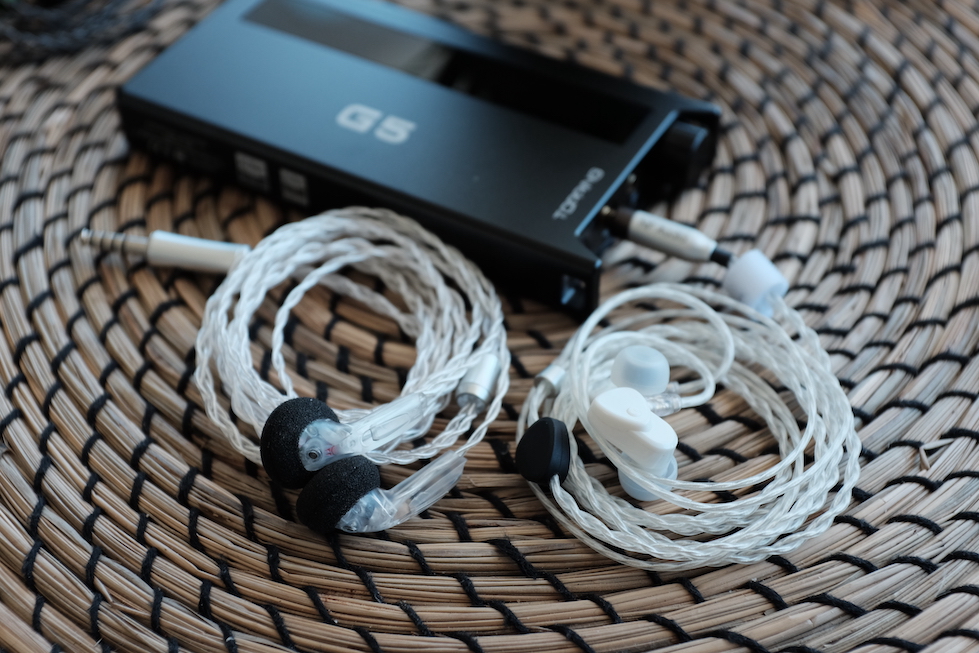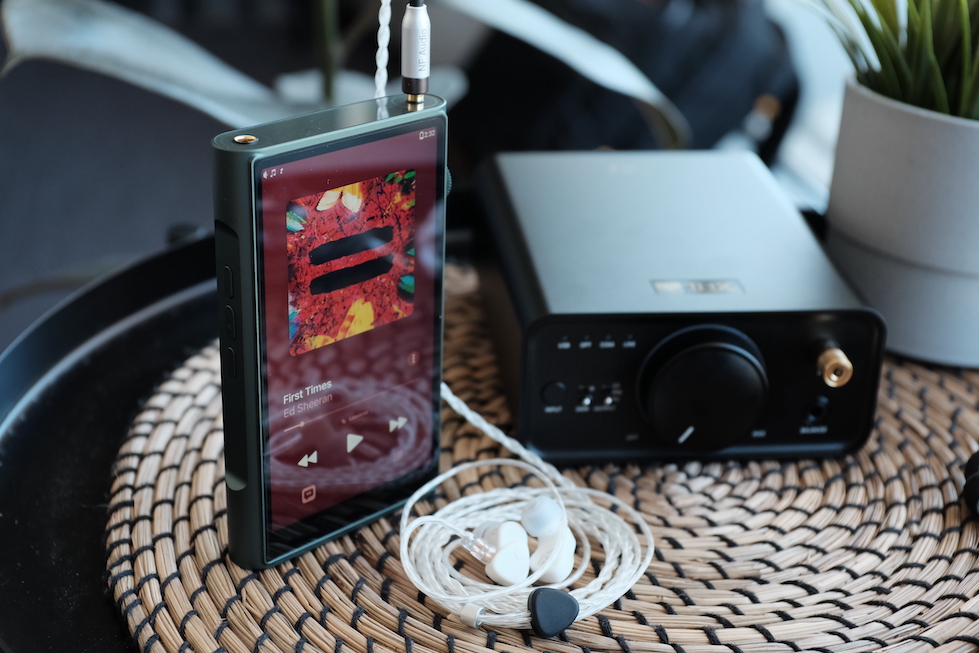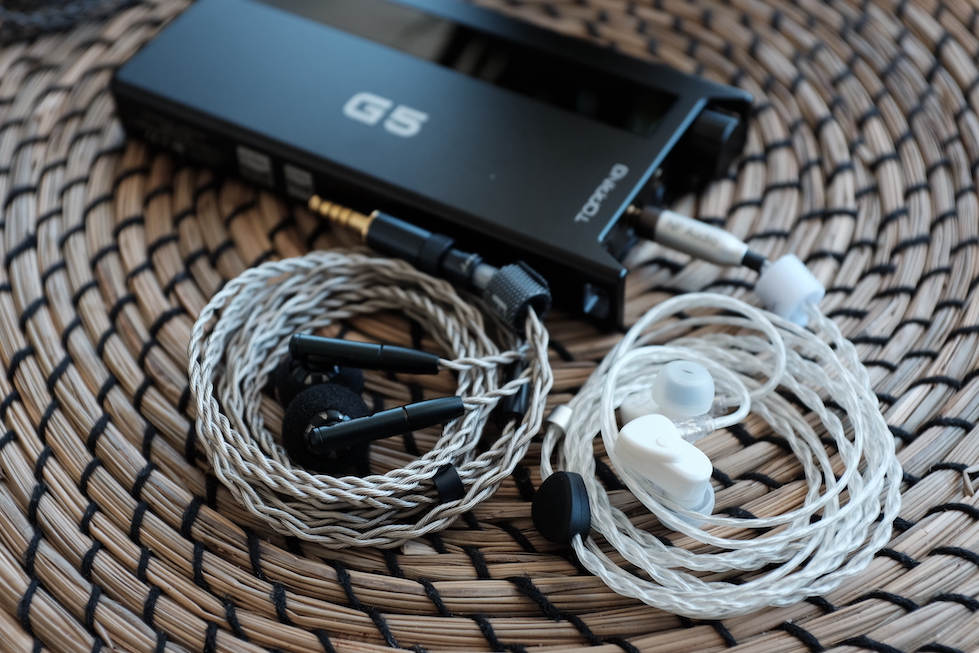NF Audio RA10
Are modern IEMs becoming too large?
One of the most common feedback I receive when giving purchase advice is, “thanks, but these IEMs are too big.” As IEMs pack more and more drivers to (try to) achieve a better sound quality, comfort takes more and more of a backseat. In the current landscape, your choices of small IEMs are limited to a few options, from Shure, Westone, and the famous Sennheiser IExxx series. This gap in the market is why I find NF Audio RA10 interesting.
Let’s talk about these tiny IEMs.
tl;dr: an alternative to the famous Sennheiser IExxx IEMs if you crave their comfort but not their bass nor their price
Forewords
- This review is based on a sample provided by Penon. Unaffiliated link to the product here
- You should treat this review as the subjective impressions of an audio geek rather than an “objective truth” about the IEM. Your experience with any IEM would change depending on your DAC/AMP, music library, ear tips, and listening volume.
- I rate IEMs by A/B testing them against a few benchmark IEMs, regardless of price point. This approach ensures the consistency of the ratings in my ranking list. It means that if two IEMs score the same, they perform more or less similar.
- I believe that great IEMs are the ones that can achieve multiple difficult things simultaneously: (1) high resolution (meaning lines of music are crisp, clear, easy to follow and full of texture), (2) 3D soundstage with a strong sense of depth, (3) bold and natural bass with a physical rumble, (4) natural timbre, (5) relaxing and comfortable tonality.
- Ranking list and measurement database can be found on my IEM review blog.
Specs
- Driver: 6mm micro dynamic driver
- Connector Type: 2-pin
- Impedance: 15ohm
- Sensitivity: 102dB/mW
Non-sound Aspects

NF Audio is an unfamiliar manufacturer to me. My experience with this brand is limited to RA10 and a few impressions shared by others in the Discovery thread on Head-Fi. As far as I know, NF Audio generally has a (delightfully?) quirky presentation with most of their products.
This characteristic carries over to RA10, a more budget offering. I like the simple but striking way they design the box, relying primarily on typography and shapes. The way NF Audio packs the content inside the box is also efficient and slightly unusual. I, unfortunately, ripped the internal packaging before the photo shoot session, so I can quite show you how it looks.
What you get in the box is more conventional:
- RA10 earpieces
- 2-pin braided cable
- A cloth bag with velour lining
- A set of silicone ear tips called MS42
Let’s talk about RA10 earpieces. They are tiny. Smaller than my Shure SE215 and matches my “IE900.” In fact, you can fit a few RA10 into the shells of chunky boys like Moondrop Blessing 2. The prime benefit of such a design is comfort. RA10 sits flush against the concha of my ears, allowing me to lie down on my side with zero discomforts. My only complaint about the earpieces is that they could be better built. The marketing material led me to believe that RA10 is constructed from dense, glossy plastic like Campfire Audio Satsuma and Honeydew. However, the plastic quality and moulding are not as good in real life. Disappointing, though understandable, given the price.
Before we move on, let’s quickly touch upon RA10’s accessories. The included cable is fully serviceable. It is thin and soft and therefore pairs well with tiny earpieces. The cloth bag is large enough to store RA10 snuggly if you roll the cable up with 4 fingers.
Regarding the ear tips, when you unbox RA10, you will notice that it is already equipped with a pair of silicone tips. I binned them immediately due to how poor they fit. The MS42 tips fit better and thus sound way better.
How it sounds
Sources for listening tests:
- Fiio K7 (for all A/B tests)
- Topping G5
- Shanling M6 Ultra
- Hidizs S9 Pro
Local FLAC files ripped from CDs or bought from Qobuz were used for most casual listening and A/B tests. My playlist for A/B tests can be found on Apple Music here.
I use the stock cable and medium MS42 for all listening tests.
Tonality and Timbre: 4/5 - Good
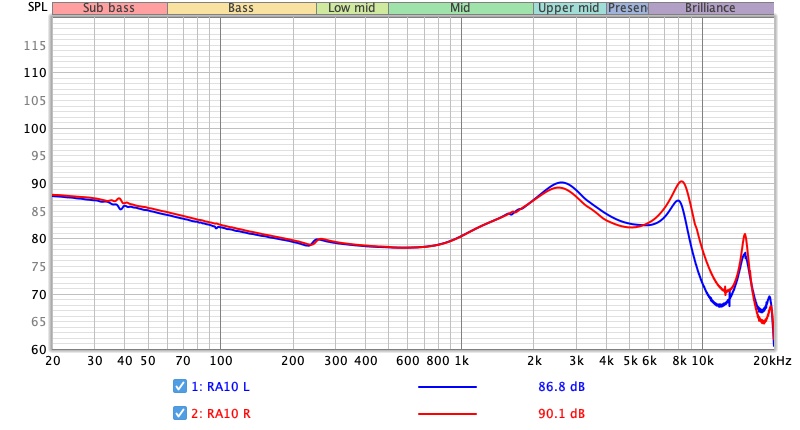
Recently, I read an essay from Arthur Schopenhauer stating that our first impressions are the most objective as our intuition has not been tainted by subjectivity and biases. Of course, Schopenhauer was talking about people, not IEMs. But for the sake of our review, let’s assume this statement also applies to expensive audio toys. Here are my first impressions of RA10:
- RA10 sounds right. None of the vocals and instruments in my test track raises any red flag. No honkiness, no nasally or strained tone, no muddiness.
- There is a sense of “lightness” in the tonality of RA10, a diffused-field, Etymotic-like sound if that makes sense to you. The midrange feels open and transparent. It means I can hear vocals and instruments clearly without feeling that some elements are masked by others. On the other hand, no warmth is added to the mid-range of RA10, so some listeners might find RA10 cold.
- RA10 sounds mild. Singers do not sound like they shout to my face. Note attacks of guitars, strings, flutes, and cymbals are not emphasised, so they do not sound like ice picks to my ears. Sibilance is not highlighted beyond what is already there in the recordings.
- RA10 feels bass-light. There is a physical sensation of sub-bass kicks at the back of my neck and in my throat now and then, but most of the time, the bass lines of RA10 are quiet. These are not punchy-sounding IEMs.
- RA10 does not sound very “hi-fi” or “audiophile.” They lack the airy sensation and micro-details, such as room reverb, to create a 3D “holographic” presentation. These IEMs present the main content of the music correctly, and that’s it.
Looking at the graph, you can see the causes of these impressions. RA10 has an almost flat lower midrange (250Hz to around 1kHz) and an Etymotic-like upper midrange (ear-gain region, about 1kHz to 3kHz). This overall structure of the tuning creates a sense of lightness and correctness in the midrange of RA10.
Despite the Etymotic-like tuning, RA10 is “mild” even when compared to Moondrop Aria and Blessing 2 because of the deep valley around the lower-treble (5kHz), where note attacks reside.
The “bass-light but still has some kicks” feeling of RA10 can be explained by the boosted sub-bass (“kicks”) without the corresponding boost around mid-bass (125Hz, the “punch” region). The lack of “hi-fi” sound can be attributed to the lack of response in the upper treble (above 10kHz).
Alright, enough with the geekiness. How does RA10 compare to some other IEMs? Firstly, RA10 sounds less warm and muffled compared to Moondrop Aria. The note weight is similar to Blessing 2 at a glance. However, in A/B tests, I found that RA10 **highlights female vocals and high-pitched instruments more than Blessing 2. **
So, what is the conclusion? On the one hand, I don’t feel anything when listening to RA10. On the other hand, RA10 sounds correct, and its tuning is elegant, like the Westone MACH 10 that I reviewed a while back. So, similarly to the Westone IEM, I rate RA10’s tonality 4/5 - Good.
Resolution, Detail, Separation: 3/5 - Average

Resolution is a fascinating subject due to the difficulty of pinning down what it really is. To me, the resolution is closely tied to how many quiet and minor details you can hear. Of course, if you turn the music louder, you can spot more details. However, you can only turn up the volume if the tuning does not have random peaks that stab your ears and mask minor details around them. Moreover, you can only hear details if the drivers manage to separate them rather than presenting a blob of sound. Earphone DIYers very well recognise this “true resolution” difference between drivers.
Let’s consider two aspects of resolution separately using the ever-vivacious One-winged Angel. Firstly, let’s analyse the micro details and texture of the instruments in the first two minutes of the recording. RA10 sounds slightly more detailed than Aria (3/5 - Average). By slight, I mean I needed to A/B multiple times and twisted my ears to pinpoint the differences.
For instance, RA10 reveals the reed sounds of clarinet and oboes more clearly. Other noticeable differences are the amount of texture and details that I can hear in the choir (especially around 1:35) and the claps from 3:40. I feel that these differences stem from the tuning, particularly the blanket of warmth that covers the midrange and masks micro-details of Aria, rather than the resolution of the drivers.
Moondrop Blessing 2 (4/5 - Good) presents a significant step up over both RA10 and Aria. From the first musical phrase, it is immediately apparent that Blessing 2 is more nuanced and micro-detailed in the midrange. The reed sounds of clarinet and oboes as well as the tremolo sections of violin are easily audible. The improvement of Blessing 2 is more than just the sharpness of note attacks. It is about the subtle details, such as the bow scratching against the string, the resonance of the violin body, and the airy sound surrounding the notes. The martele bowing at the beginning demonstrates these points clearly. Next to Blessing 2, both RA10 and Aria feel truncated, like a layer of information is lost.
Secondly, let’s analyse the separation of instruments and vocals when the music gets busy, from 2:30 onward. Aria feels duller and denser. Instruments are less separated compared to RA10. The thinner midrange of RA10 makes the instruments seem more detached. Notes attacks of RA10 are sharper.
Again, Blessing 2 is a clear step up compared to RA10 and Aria. With Blessing 2, all instruments are separated and layered rather than mushed together, making it easy to follow individual parts. Such the ability to clearly render dense music is the indicator of the actual resolution. Thinning out tuning and boosting treble can improve the perceived clarity. Still, these tricks would fall apart when many elements of a mix overlap.
What’s the conclusion? RA10’s resolution is perfectly adequate for listening, but noticeably one step below good performers. I couldn’t help but yearn for a little more detail and separation. **3/5 - Average. **
Percussion Rendering: 2/5 - Below Average
Percussion rendering reflects how well the tuning and technical performance of an IEM work together to recreate realistic sound of a drum set. Good drum hits have a crisp attack (controlled by frequencies from 4kHz to 6kHz), full body (midbass frequencies around 200Hz), and physical sensation (sub-bass frequencies around 50Hz). Good technical performance (“fast” driver) ensures that bass notes can be loud yet detailed. IEMs that cannot control bass very well tend to reduce the bass’ loudness to prevent muddiness.
Based on the description above of the tonality, you might already guess that RA10 is not a good performer in this aspect. But for the sake of completeness, let’s analyse some test tracks.
The first test track is Dragonborn. I mainly focus on the rumble of the opening phrase. Aria (3/5 - Average) shows a strong bass rumble. After every “thump” sound, you can feel a rumble “brrr” at the back of your neck and in your throat. That’s an indicator of sub-bass. On the other hand, RA10 has little to no rumble. **It only renders an unenthusiastic “thump” sound, and that’s it. **
The second test track is Despacito. This track calls for big, bold, “dirty” bass to satisfy the drops throughout its chorus. Again, Aria produces noticeable bass punches and rumble. The bass drops have decently sharp attacks, better than I remember (showing how much one should be sceptical of impressions from memory). However, the texture within the bass feels overly smoothened, making the bass notes feel big but blunted, like punching a pillow. But at least the bass is there.
With RA10, bass drops are there but faded behind the midrange. Because the bass is quiet, it feels snappier than Aria. However, when I listen very carefully, I find that the quality of the bass is the same. RA10 feels snappier simply because its bass is quieter, thus disappearing faster, thus “snappier”.
Despite my usual complaint about the texture and detail of Blessing 2’ bass (4/5 - Good), it is still one big step ahead of Aria and RA10. The bass extends deeper, bass notes are more precise, and every drop is more satisfying.
Out of curiosity, I dug my E5000 (5/5 - Excellent) out for an A/B test. This bass canon stomps all of them (when powered by a desktop DAC/amp).
Conclusion: 2/5 - Below Average. The bass quality is barely average, and the quantity is insufficient to render percussion instruments and bass with any gusto. At the same time, it lacks the sharp bass attacks of BA-based IEMs. If you don’t like bass or your library does not need bass, you might enjoy this presentation. For me, this performance level needs to be improved.
Stereo Imaging (Soundstage): 3/5 - Average
Stereo imaging or “soundstage” is a psychoacoustic illusion that different recording elements appear at various locations inside and around your head. Your brain creates based on the cues such as the loudness and phase differences between the left and right channels. Most IEMs do not differ significantly, nor can they compete with headphones or loudspeakers. However, some IEMs offer a more spacious soundstage than others. Best IEMs can create multiple layers of sound from closer to further away and make some instruments float slightly above your head.

RA10 sits closer to my eardrums and does not have a lot of vents. It does not have a deep bass response or extended treble. Therefore, it is evident that RA10 does not have a good soundstage.
Let’s analyse my favourite test track: Synchro (Bom-Ba-Ye). We focus on the first minute of the recording. Aria (3/5 - Average) sounds is noticeably wider than RA10. The hand claps of RA10 shape a soundstage that is strictly in my head, whilst Aria places the claps slightly outside my head. When the orchestra comes in around 0:15, again, Aria paints a broader picture that extends further outside my head, whilst RA10 keeps everything mostly inside my head.
Aria and RA10 fail to project a 3D soundstage with layers and complexity, but they fail differently. Aria presents a wall of sound where all instruments are compressed onto a shallow but wide layer. On the other hand, RA10 presents the soundstage as a blob of sound within my head. The stage has depth, meaning instruments can appear (slightly) in front of me. Still, it’s hard to pinpoint and separate the closer and further away instruments, so the sense of layering could be stronger.
Let’s try something unusual by analysing the soundstage of these IEMs in a video game. For this test, I use CSGO gameplay footage. RA10 is noticeably better than Aria. You can imagine the sound of RA10 as a small circle within your head. You can pinpoint the direction of gunshots within this circle. You can also identify distance, even though such a task is rather difficult due to the small soundstage pushing everything nearer. On the other hand, the Aria can only tell you whether the sounds come from the left, right, or centre. Moreover, anything that happens at the centre feels very closed in.
Conclusion: 3/5 - Average. Mostly in the head soundstage but with decent depth and imaging accuracy.
Source Pairing
RA10 is not easy to drive.
What does that mean? It does not mean you cannot get loud sounds from these IEMs. Yes, these IEMs require extra volume compared to others. However, any decent dongle can get these IEMs loud with plenty of volumes left to turn up.
The problem is that you might get only some of the crispness and decent soundstage performance I described. When powered by the Apple dongle or even the AP80 Pro X music player, RA10 sounds denser and more compact. Using something like Fiio KA3 would flatten the soundstage, as it is how KA3 sounds. Using a source with a “desktop effect” like G5, Shanling M6U, or a real desktop DAC/amp can make everything wider and more separated. As I did all of my A/B tests with K7, I have already pushed RA10 to its limit.
Since DAC/amp is a questionable topic, let me rephrase myself. I’m not saying that you need to buy better sources to make the most of RA10. I am trying to say that dual-ESS DAC dongles might not give you all the technical performance I described in this review. Fortunately, the tuning and comfort remain intact.
Conclusion
As IEMs get chunkier and more uncomfortable, it is refreshing to see a new release with micro-drivers and tiny shells. It’s fortunate for listeners with smaller ears that RA10 is also a competent IEM. If you are after a small and comfortable IEM for resting or watching random YouTube videos, RA10 is worth consideration.
Pros:
- Small and comfortable shells
- Tonally correct
- Competent level of clarity and detail
- Good imaging accuracy
Cons:
- Weak bass response
- Small soundstage
- They don’t look as good as the marketing materials
